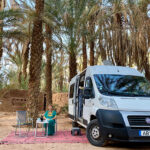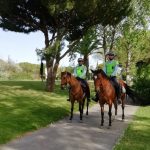Most people are familiar with the excellent wines of the Douro and the Alentejo but Guillaume Leroux, a local winemaker, is making sure that the Algarve is firmly on the map too.
Monte da Casteleja, near Lagos, with its traditional Algarvian ‘quinta’, is a seven hectare farm just past the aerodrome on the road to Sargaçal. I learn that on the ‘monte’ or hillocks overlooking green undulating countryside, there is evidence of an earlier Roman castle; hence the name ‘casteleja’. I am not wholly surprised to find out that wine is likely to have been produced on this spot many centuries ago.
For over ten years Guillaume has been growing vines here. He firmly believes that the Algarve can produce good quality wines provided local conditions are taken into account. And he has gone one step further by being the first in the region to produce and market organic wine.
As a wine lover, I was looking forward to meeting Guillaume and finding out about his endeavours. I wanted to know what’s special about the wines he produces and how he can possibly compete with established wines in other regions.
He greets me at the entrance of the farmhouse, which is painted in a fresh white and blue colour. I am taken by his bouncy enthusiasm and his eagerness to show me what he has accomplished.
As we walk around the grounds, Guillaume tells me more about himself. Born in Paris of a French father and Algarvian mother, he spent his childhood in Portugal. “My father was a great lover of Portuguese wines and this passion was passed on to me early, ”he explains. “I always remember him selecting a bottle from his cellar to enjoy with a meal.”
After his father’s death, he inherited the farm, which was originally bought by his maternal grandfather, but who never cultivated it himself as he was involved in the fish canning industry.
Having chosen viticulture, Guillaume went on to study winemaking at a college in Montpellier, Paris, followed by postgraduate studies in Oporto. “Producing wine in the Algarve was always uppermost in my mind but I worried about the climate and the lack of a quality winemaking tradition in the region,” he points out.


His month-long stint working at vineyards in Australia was a turning point. “Yes! I thought. Australia has the same arid conditions as the Algarve so it would be possible to do it successfully here too,” he enthuses. With his subsequent experience of working at vineyards in central Portugal and the Douro region, he set about realising his ambitions.
After much research into climatic conditions, analysis of soil and choice of grape varieties, he planted his first vines in 2000 with some financial assistance from the government.
The selection of grapes for arid conditions was crucial. The red variety, ‘Bastardinho of Sagres’ which he had come across in the
Douro was nearly extinct in the Algarve. It was right for the region with its full-bodied and complex characteristics and blended well with ‘Alfocheiro’, his second variety.
For white wine, he opted for the popular ‘Arinto’ and the lesser-known “Perrum’ which combined well to give good structure, acidity and complexity.
“We had to wait three years before harvesting the crops and only the following year did our first wines go on sale. But it was a milestone for us,” he smiles.
Three and a half hectares of the farm are devoted to vines, in addition to small almond, fig and olive plantations.
“We can’t compete with the big wine producers. Instead, we need to concentrate on high-quality wines, using indigenous varieties where possible,” he maintains.
He is particularly concerned about the scarcity of water and doesn’t want to be reliant on irrigation. In order to help plants survive, he uses a method which seems bizarre at first but makes perfect sense as he explains: “We have more plants per hectare than normal – 5000 as opposed to 3500 – and the space between rows is only 2 metres. Plants compete for space, developing longer roots, making them more likely to survive when it is dry. The height of the vines is also reduced so less water is needed.”


On the southern part of the farm where red vines are planted in the clay-rich soil, I notice weeds growing prolifically with hardly any bare soil visible. It becomes clear that this is a topic close to his heart as he launches into an animated exchange. Six years ago he started the process of organic cultivation, without using any artificial pesticides or chemicals. “It is a huge learning curve,” he maintains, “you have to be in touch with the environment to observe and learn how plants and soil interact.” The soil is mulched and covered by hay to avoid exposure to the sun. He plants ‘green manure’ in the rows, including leguminous plants, to provide oxygen and nitrogen and is always experimenting with plants that keep pests at bay. He is keen to combine traditional methods with new technologies.
August harvest time – the peak of the wine-growing season – is when locals and visitors turn up for the traditional treading of the grapes. It is a real community affair with food and wine laid on for workers in a shaded corner of the courtyard.
Besides full-time members of staff, there is always a need for additional help.
During the year, volunteers on the WWOOF scheme (World Wide Opportunities on Organic Farms) work on the farm in exchange for food and lodging. Guillaume thinks it is an excellent mutual arrangement, as people from different parts of the world also benefit from the exchange of experiences.
Guillaume’s enormous persistence in dealing with the bureaucratic process paid off and he is very proud to have achieved the right to use the label ‘organic wine’ on his bottles – the first one to do so in the region.
Because of new regulations for processing wine, the vineyard is currently expanding. A new vinery, cellar, reception area and shop will be completed this year. It’s a huge investment, but Guillaume believes it’s well worth it.
In the current reception area, samples of his red, white and rose ‘Monte da Casteleja’ wines are displayed in attractive packages. There is also the exclusive red ‘Maria’ selection and ‘Meia Praia’, specifically produced for restaurants. I have had the opportunity to try most and I must say I am impressed!
I notice a display cabinet in one corner of the room with a number of Roman and prehistoric artefacts. “When I dig in the vineyard, I quite often come across old remains. I have become quite expert at identifying them by now!” Guillaume laughs, “It is believed that the very first settlers in Lagos – the old ‘Lacobriga’ – lived here with the sea coming much closer to the property. Lots of pieces of amphorae show that wine was stored.”


‘Monte da Casteleja’ has the capacity to produce 15,000 bottles a year, mainly for the Algarve and Lisbon, where there is an increasing demand for organic wines.
The wine is mostly sold to small supermarkets, wine bars, restaurants and hotels and at various fairs across the country. “It takes time to build a reputation but I think we are getting there,” he says.
Guillaume has certainly achieved a considerable amount in a few years. He is producing wine of the highest quality for a niche market. He is also sensitive to the local environment and has embarked on his journey to produce organic wine.
He is keen to promote eco-tourism and his farm is the first one to be part of the western leg of the newly established ‘Wine Routes of the Algarve’.
Guillaume welcomes visitors to guided wine tasting tours at the farm throughout the year, always eager to talk about the art of winemaking. Here one can sample the wine and other local produce in a pleasant setting.
‘Monte da Casteleja’ with its unique and rich past is on its way to making a mark in the region. Cheers to that! I think the Romans would join me in raising a toast!
Facebook: Monte da Casteleja













